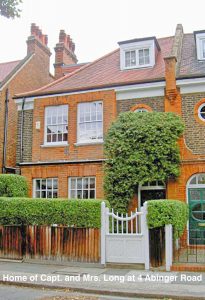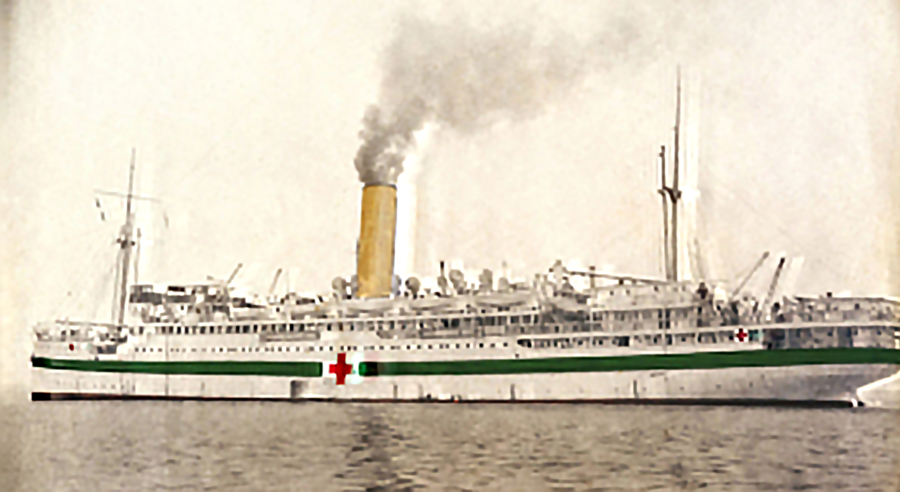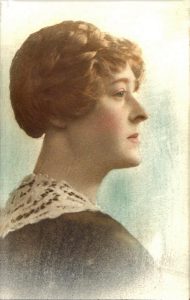St Michael & All Angels Church is commemorating the Centenary of the Armistice, which marked the end of World War 1 on November 11th 1918.
See our Remembrance: St Michael’s & World War 1 pages for more details and updates. You can now read the Clarion – Armistice Centenary Edition – 1918 – 2018 here online.
- Our fifth annual exhibition commemorating those from the parish of St Michael & All Angels Bedford Park who died in World War 1 opened on Friday November 9th in the church and will close on Friday November 30th.
 Those remembered include Mrs Violet Long OBE, Chief Controller of the Women’s Army Auxiliary Corps, who drowned when the Ambulance Transport ship HMAT Warilda was torpedoed on August 3rd 1918. She was 35 and the only woman remembered on our memorials.
Those remembered include Mrs Violet Long OBE, Chief Controller of the Women’s Army Auxiliary Corps, who drowned when the Ambulance Transport ship HMAT Warilda was torpedoed on August 3rd 1918. She was 35 and the only woman remembered on our memorials.
 Violet lived at 4 Abinger Road, Bedford Park W4, and, at the start of the war, helped in the training of candidates for the St. John Ambulance Society in St Michael & All Angels Parish Hall. In 1917, the various women’s voluntary bodies were reorganised into a paid government service, the Women’s Army Auxiliary Corps. Mrs. Florence Burleigh Leach became its second Chief Controller and appointed her sister Violet as her deputy, latterly Chief Controller for Administration.
Violet lived at 4 Abinger Road, Bedford Park W4, and, at the start of the war, helped in the training of candidates for the St. John Ambulance Society in St Michael & All Angels Parish Hall. In 1917, the various women’s voluntary bodies were reorganised into a paid government service, the Women’s Army Auxiliary Corps. Mrs. Florence Burleigh Leach became its second Chief Controller and appointed her sister Violet as her deputy, latterly Chief Controller for Administration.
On August 3rd 1918, HMAT Warilda was transporting over 600 wounded soldiers from Le Havre to Southampton. Her white superstructure and large red crosses were intended to give her the protection of the International Committee of the Red Cross but, as with other hospital ships, Germany claimed the ships were also carrying arms. Chief Controller Violet Long had taken a contingent of staff to France to work with the American Expeditionary Forces and to gather information for a report. With her work completed, she managed to get a berth back to England on board the Warilda with her orderlies. Characteristically, Violet was the last woman to leave the ship, having made sure the two QMAAC in her care were safely off. As Violet boarded the lifeboat it lurched and capsized and she fell into the sea.
- You can see more details, and pictures of Violet Long from her family’s album, at our WW1 Project website, together with details of 127 servicemen named on our war memorials. The Project has been supported by the Heritage Lottery Fund. You can see a list of The Fallen – year by year here; and The Fallen – road by road here. The exhibitions represent a fraction of the research material on the website. There are links to images from the four previous exhibitions here.
- More than 500 poppies have been knitted by the congregation and are displayed on the Parish Memorial – the rood screen at the heart of the church – and around the church. The Holy Rood in Memory of those Fallen in the War was unveiled on Saturday September 28th 1918. The bronze plaque next to it, inscribed with the names submitted by the congregation of the 91 Fallen from the Parish, was finalised some months later in 1919.
- St Michael & All Angels is also displaying 10 silhouettes of the fallen which it has been awarded under the Armistice and Armed Forces There But Not There programme, which brings communities together to remember and to think about the Armed Forces today. Some will be grouped near the Parish Memorial Plaque in the church, representing specific members of our church community from the choir and the servers team. Others will be situated in the midst of the congregation.
- Our Choral Requiem Mass on Remembrance Sunday, November 11th 2018, was followed by a procession to the Bedford Park Memorial Seat outside the Parish Hall. You can see pictures here. A special Remembrance Sunday Evensong included music, poems and readings.
- The censer, or thurible, used in the Requiem Mass was found in the ruins of a village church in Flanders in 1918 by Corporal Arthur Smart, the then Sacristan of St Michael & All Angels. He presented it to the church on his return and it was restored and refurbished in 2017. It is inscribed “Salved in France 1918 by A Smart, Sacristan and Soldier”.

